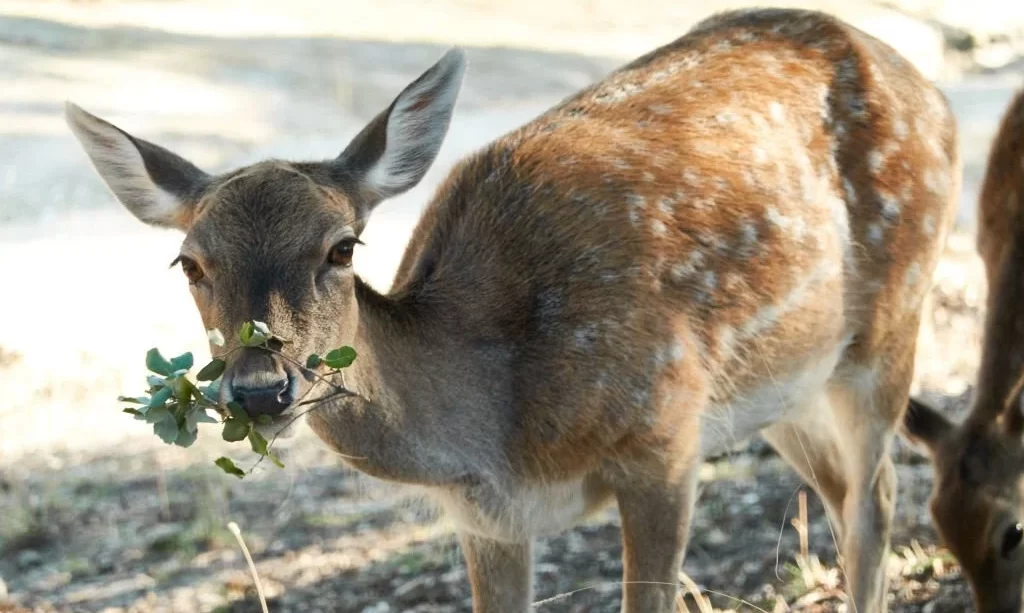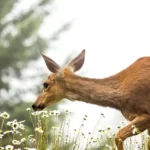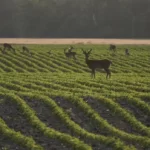In the enchanting world of gardening, few trees rival the timeless allure of the fig tree. With their lush foliage and delectable fruits, fig trees have been cherished by gardeners for centuries. However, as we cultivate our green havens, another presence often wanders in – deer. These graceful herbivores can be both a delight and a challenge in our gardens, leaving us to wonder: Do deer indulge in the sweet bounty of figs? In this article, we embark on a journey to understand the complex relationship between deer and fig trees. Join us as we explore the world of these magnificent fruit-bearing trees and delve into the dietary preferences of the elegant herbivores that share our landscapes.
- Fruit Tree
- 4 Rooted Fig Chicago Hardy plants
- Starter live plants
About Fig Trees
Before we embark on our exploration of the deer-fig dynamic, let’s take a moment to appreciate the richness of fig trees. Fig trees belong to the Ficus genus and are known for their distinctive lobed leaves and, of course, their delicious fruits. These trees come in various species, each with its unique characteristics, but they are universally admired for their versatile fruit, which can be enjoyed fresh, dried, or in a multitude of culinary creations.
Fig trees not only grace our gardens but also hold cultural and historical significance in various societies. They are symbols of abundance, fertility, and even wisdom in different traditions. The appeal of fig trees extends beyond their fruit-bearing prowess; they often serve as stunning focal points in landscapes, combining ornamental beauty with culinary abundance. Yet, as fig enthusiasts and gardeners, we must consider whether these iconic trees are susceptible to the grazing preferences of deer.
Deer Behavior and Feeding Habits
Understanding the intricate interplay between deer and fig trees requires a glimpse into the world of deer behavior and feeding habits. Deer, as herbivores, have a diet primarily composed of plants. Their choices are influenced by the seasons, the availability of food sources, and individual preferences.
Deer are often described as opportunistic browsers, which means they adapt their diet based on what is accessible and palatable. While deer typically prefer tender, moisture-rich plants, such as grasses, forbs, and shrubs, they may occasionally explore other options. This adaptability can lead to variation in their feeding habits, both within different seasons and across regions.
In the following paragraphs, we’ll delve into whether fig trees are among the favored choices of deer for browsing and the factors that influence their interactions with these beloved fruit-bearing trees.
Do Deer Eat Figs?
The question of whether deer indulge in the luscious sweetness of figs can have nuanced answers. Generally, fig trees are not at the top of a deer’s menu. Figs, with their unique leaves and fruit, do not typically constitute a significant portion of a deer’s diet. These fruit-bearing trees have characteristics that can make them less appealing to deer.
Firstly, the leaves of fig trees often contain latex, which can be bitter and unpalatable to deer. Additionally, fig leaves tend to be tougher and more fibrous than the preferred vegetation of deer. While deer are opportunistic feeders and may sample a variety of plants, they generally seek out plants that are tender and moisture-rich.
Moreover, figs produce their fruits high above the ground, making it less convenient for deer to access them. Deer are more likely to browse on plants that are within easy reach.
However, it’s essential to acknowledge that deer behavior can vary based on factors such as regional deer populations, local food availability, and individual deer preferences. In areas with high deer populations and limited alternative food sources, deer may be more inclined to sample figs, especially when they are ripe and accessible.
Factors Influencing Deer Feeding
Several factors can influence whether deer choose to feed on figs from fig trees:
- Local Deer Populations: The presence and size of local deer populations play a significant role. In regions with abundant deer, these herbivores may be more inclined to explore various food sources, including figs.
- Food Availability: The availability of alternative food sources can greatly influence deer feeding habits. If deer have access to plenty of their preferred forage, they may be less interested in figs.
- Seasonal Changes: Deer’s dietary preferences can change with the seasons. During spring and summer, when tender plants are more readily available, they may be less inclined to feed on figs. However, during periods of food scarcity, such as winter, figs may become a more appealing option.
- Deer Preferences: Individual deer may have unique preferences for certain plants. Some may be more likely to explore figs, while others may focus on different food sources.
In summary, fig trees are not typically the first choice for deer when it comes to foraging. While deer may occasionally sample figs, especially when other food sources are scarce, fig trees are generally not considered a significant target for deer browsing. Understanding these dynamics can help gardeners and growers make informed decisions about protecting their fig trees from potential deer damage.
Protecting Fig Trees from Deer
Gardeners and fig enthusiasts who wish to safeguard their beloved fig trees from potential deer browsing can employ several strategies:
- Fencing: Installing deer fencing or tree guards around fig trees is an effective way to create a physical barrier that prevents deer access. Deer fencing should be tall enough to deter deer from jumping over it, usually at least 8 feet in height.
- Deer-Resistant Plants: Planting deer-resistant species around your fig trees can help deter deer from approaching. Some examples of deer-resistant plants include lavender, rosemary, and barberry.
- Repellents: Scent-based repellents can be applied to fig trees to make them less attractive to deer. These products emit odors that deer find unpleasant. Keep in mind that repellents may need to be reapplied periodically, particularly after rain.
- Pruning: Pruning the lower branches of fig trees can make it more challenging for deer to access the foliage and fruit. This can be an effective way to deter browsing.
- Garden Design: Consider the layout of your garden. Placing fig trees closer to your home or near frequently visited areas can make deer less likely to approach, as they tend to be more cautious when they perceive human activity.
- Tough durable deer netting; Protects landscape and crops from deer and other animals
- Economical, lightweight deer protection; Black UV-resistant deer netting
- Reusable mesh deer fence; Stops deer and other animals from eating shrubs, berries, and vegetables
- Easy to use roll of deer fence netting; Attaches easily to posts and trees
- Do it yourself deer netting for protecting trees, shrubs, orchards and crops
Final Thoughts
In conclusion, the relationship between deer and fig trees is one where the beloved fruit-bearing trees are not typically the primary target of deer browsing. Figs possess characteristics that make them less appealing to deer, such as the latex content in their leaves and the location of their fruits high above the ground.
However, it’s crucial to recognize that deer behavior can be influenced by various factors, including local deer populations and food availability. In areas with significant deer populations or during times of food scarcity, deer may be more inclined to explore figs as a food source.
Gardeners who cherish their fig trees can take proactive measures to protect them from potential deer damage. By employing strategies such as fencing, planting deer-resistant companions, using repellents, and thoughtful garden design, it’s possible to enjoy the delectable fruits and ornamental beauty of fig trees while minimizing the impact of deer browsing.
Ultimately, striking a balance between preserving your fig trees and coexisting with local wildlife is the key. With the right precautions and considerations, fig trees can continue to thrive and provide their delicious bounty in gardens and landscapes.






